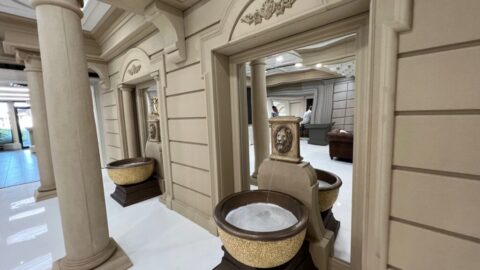Patterson Whittaker Architectural Profiles is North America’s leading provider of cemented coated Expanded Polystyrene (EPS) architectural products. These products are widely used for exterior – and interior – features of both commercial and residential properties, including moldings, columns, cornices, and window trims.
These provides provide a phenomenally lightweight alternative compared to traditional wood, concrete, and other materials, offering much easier installation, lower cost, and more.
One concern that many people have, however is about durability. EPS is, in theory, noticeably more fragile than concrete, and some people are concerned that their architectural designs will not hold up – especially in commercial properties, but also in residential ones as well. This concern continues even though our products are coated with reinforced cement for added durability.
Can cement coated EPS products withstand force?
Spoiler: Yes – in Most Situations
EPS products are made from a lightweight foam core, which is coated with a cementitious mixture that adds rigidity and provides a textured, stone-like finish. The EPS foam core offers a high strength-to-weight ratio and can be shaped into various intricate designs, while the cement coating enhances impact resistance and weather durability.
Key structural properties of cement-coated EPS products include:
- EPS Core – Lightweight, compressible foam that forms the base structure of the product, allowing easy installation while reducing the overall load on the building.
- Cementitious Coating – A layer of cement-based material that adds strength, impact resistance, and a hard, durable exterior finish to the EPS core.
This combination aims to balance flexibility and rigidity. While the cement coating provides protection against environmental factors and minor impacts, the EPS core allows some compressibility, contributing to the product’s resilience under certain forces.
The performance of cement-coated EPS under force depends on several factors, including the thickness of the EPS core, the strength of the cement coating, and the type of force applied. Forces that affect these products can be broadly classified into two categories: bending forces and direct impact forces.
Bending Forces
Cement-coated EPS products can resist minor bending forces, but their structural limitations mean they are not intended to bear significant loads. The EPS foam core is relatively rigid but flexible enough to withstand slight bending without damage. However, excessive bending force can cause the cement coating to crack, as cementitious materials have low tensile strength and are prone to breaking under tension.
In typical applications, these products are installed in ways that minimize bending force. When used in vertical applications (e.g., wall moldings or columns), the bending forces are minimal, and the cement-coated EPS can maintain its shape and integrity.
Thus, cement-coated EPS products can withstand minor bending forces if properly supported and installed, they are simply not load bearing. This does not differ much from other materials, either. Even GFRC architectural products are typically not load bearing, but in the case of cement coated EPS, installing in such a way as to minimize bending force is ideal.
Direct Impact Forces
When exposed to direct impact, such as a sudden hit or collision, cement-coated EPS products generally respond in one of two ways:
- Minor Impact – The cement coating provides a degree of impact resistance, allowing the product to withstand minor bumps or knocks without significant damage. The EPS core absorbs some of the impact, preventing the product from cracking under low-level force. The cement is also reinforced, which reduces damage taken.
- High-Impact Force – Under high-impact force, the cement coating may crack or chip, and the EPS core may compress or deform. While EPS itself is somewhat flexible and can absorb some shock, the rigid nature of the cement coating makes it susceptible to cracking or breaking when struck with significant force.
For instance, if a heavy object were to fall onto a cement-coated EPS molding, the outer cement layer would likely crack, and the foam core may be compressed. While this would not necessarily compromise the entire structure, it could result in visible damage that requires repair.
However, once again it should be noticed that this is not particularly different from other materials. Even wood and concrete can break with high impact, and the repair for those materials is often a lot more difficult and expensive than replacing architectural EPS.
Get Specific Help with PW Profiles
Most of the time, cement coated EPS can handle more than enough force, and while it may weaken at high impact, that is true of many other materials as well.
If you’re looking for the specific architectural details about Patterson Whittaker Architectural Profiles, and you’d like to learn more about its force resistance, the best thing you can do is reach out to our team. Our sales team will provide you with the data you need and show you samples so you can see the durability of our architectural EPS.




